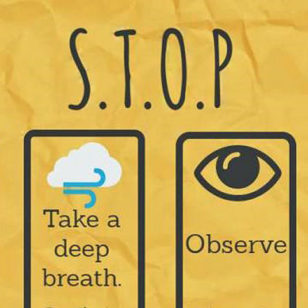What They Don’t Tell You About Self Love
For years I had heard this statement, “You have to love yourself first.” Year after year, hearing the same sentence, and knowing that somehow that must be true, only to be stuck with a growing frustration about what this meant and how to do it. You see, for me, this felt like when someone tells you that something is right in front of you face but you cannot, for the life of you, see it.
Imagine a huge white wall with a white door and no seams or handle. Finding the door is seemingly impossible, yet people keep telling you it is there, all your self-worth and your consciousness of it are there behind that door, just waiting for you to open it.
Uh.. yeah…right.
Just the same, I could sense that they were right, because the symptoms were there…
I had suffered through many difficult relationships and did not take responsibility for my part in that suffering. I had put the priorities of others above mine, often then playing the victim when I felt taken advantage of. I chose partners who fed into this dynamic upholding this pattern of “sacrificing myself”. I cared way too much of what others thought of me, leaving me open to predators or manipulators.
I gave away my power and my identity, of course, expecting love or affection in return. When I did not get it, I was disillusioned, angry and often ashamed. The fact that I did not receive love in return for this behavior reinforced my sense of not being worthy of love and brought me to very dark places.
Even when I was aware of this behavior and took responsibility for it, I was still baffled about how to get to the point where I had a healthy love and respect for myself. If I was aware of these behaviors, why did I keep repeating them?
All the while, the same message kept creeping back in: “You have to love yourself,” “You cannot love others until you love yourself,” and so on. And the message came with this subtext that it is really that easy. Just look at yourself in the mirror every morning and say, “I love you!” After a while, you’ll get used to it and magically you will love yourself.
Apart from this sounding silly to me, these types of solutions just made me more frustrated because I thought that if it is that easy, why aren’t we all just beaming with self-love? To add insult to injury, friends and family generously expressed their admiration and love for me, yet I still couldn’t see it for myself. Because the truth is, it is not that easy.
Loving yourself is not a light switch that you can turn on and off. It does not follow the logic of your mother’s eternal compliments. It is a process which involves work, attention and courage. I don’t have the answer for everyone but I will share a few things that helped me finally be able to open that white door on the white wall.
Step 1
Observation: I observed and recognized the behaviors on the surface that were causing me suffering without judging myself.
Through the practice of mindfulness I learned to observe my my thoughts, emotions and bodily reactions to different events in my daily life. I began to detect patterns and automatic reactions that I had to people and situations. I noticed my thought patterns, ie. going over and over a situation or problem — what I said, what I did not say, what I should have said, etc. Perhaps the most powerful aspect being the attention to my body.
The body never lies and when we are feeling threatened or altered by a situation, we inevitably have a bodily reaction. For example, sometimes I would catch myself giving in to someone or doing things that I did not really want to do, out of fear of disappointing them. Although it was too late to respond differently, I could notice that my body had already been hard at work, warning me with a stiff neck or a contraction in my chest or some other physical sign. As I got better at this, I was able to notice the body’s signals before reacting.
In mindfulness practice, while you observe you can label what you perceive. I would say to myself, “I just placed so-and-so’s needs before mine, ” or “I just said yes to going to dinner, but I really don’t want to go,” etc. It is key to maintain a non-judgmental attitude while doing this, so as to not fall into the trap of making yourself then feel bad about your behaviors or reactions.
It became sort of like a game for me. Observing this with an attitude of non-judging and curiosity actually opened a space for a sense of humor and compassion towards myself, the first step towards self-love.
Step 2
Introspection: I looked beneath the behaviors I had observed to uncover the programs and limiting beliefs that caused them.
One of my mindfulness teachers once asked me a very powerful question: What do you do to keep your parents happy? We are not talking about cleaning the dishes or helping out around the house. The question is: Who are you still pretending to be, so as to your parents happy and receive their love?
The answer to this question resides in our youth, when we developed masks that helped us “survive”. Indeed, we needed these masks and some were perhaps much heavier than others.
Some of us always did what our parents wanted, so as not to upset them. Or maybe our mask was to cause a little trouble in order to get the attention we needed as a child. Our masks then followed us into our adult lives and keep us chained to our outdated behaviors. When we don’t get the result we expected (love, affection, etc.), we experience suffering.
If pleasing your parents was how you thought you would earn their love when you were little, then perhaps now, as an adult, seeking approval from your spouse, friends, workmates, etc. is your first line of defense to ensure their love or attention. Or, perhaps you “kept your parents happy” by overachieving and showing them your worth by getting the best grades, position on the football team or the lead in the play. Perhaps today your mask rears its head by showing off or demonstrating your abilities to others, with the false belief that their love for you depends on your ability to achieve.
These are limiting beliefs that we are often not even aware of, and the mask they have helped us create gets heavier and heavier as we advance through life. It takes courage to look at these masks and admit to ourselves that we have them, that we no longer need them and that we have been behaving based on a limiting and erroneous belief about who we are and how to earn love and affection.
When you finally put down the mask, even if for a few minutes, you realize that there is something else there… an essence of you, a true you. You may even feel sadness because you are also releasing the person you thought you were. Guilt or regret may arise when you realize that you have, in a way, been living a lie for years.
Thankfully, on the other side of that coin is relief. You have come home. It may be hard to see this “original” self clearly, but it is enough just to sense that your own authentic existence is there.
Who are you, then, if you are not the mask you have been wearing since childhood?
Step 3
Acceptance and Integration: When I became aware of my essence, this being who existed behind the mask, I felt that a whole world of possibility had opened up to me.
After the initial shock (and mourning) of realizing that I had been living a feigned existence, I became excited to see that there was now a person there who I could get to know. I was no longer trapped and obligated by an outdated mask and outdated beliefs. I could choose who I wanted to be and how I wanted to be.
Then, like the snowball effect, I started listening to myself more, respecting my true desires and wishes. It gets easier to recognize and differentiate between what is really a genuine and authentic reaction from what is an old habit or pattern. Mindfulness and meditation helped me through this process particularly since there is an element of compassion involved.
Non-judging, non-striving, beginners mind… these attitudes of Mindfulness became the fertile ground where I could take a realistic look at myself and essentially re-educate myself (some would say, re-program) by accepting who I have been up until that point and integrating all my masks and behaviors (not rejecting them), yet letting them also rest or fall away, if I may, and allow my true nature to surface, as is.

Through observation, introspection and acceptance I had found the seam of the white door and was able to then open it. Perhaps loving oneself is so difficult because what we are trying to love first is our mask or the version of ourselves that contributes to our suffering, the same version of ourselves that we sometimes cannot stand. I needed to recognize this mask, accept it and integrate it as part of me before I could even know who I was to love.
This is, of course, a process. Old habits take a while to transform or change. I still work on it every day. The key is to have patience and not force things. By practicing mindfulness and meditation and adopting some of the attitudes of mindfulness, such as non-judging, beginner’s mind, acceptance, non-striving and patience, I was able to do this work in a way that I had not been able to before and begin the process of self-love.
As a final note, I did not do this alone and I do not recommend that anyone do this alone. Doing the work of putting into consciousness who you have been and who you truly are is absolutely rewarding and totally worth it, but not without some moments of fear, sadness, grief or other difficult feelings that must be dealt with. I deeply encourage having a support group to work with, a mindfulness professional, a therapist or someone to support you through the difficult parts of this process.
Once you do get that door open, you’ll never look back.
About the Author
 Victoria Fontana, founder of mindgazing.com, is a Meditation and Mindfulness Consultant and Teacher based out of Madrid, Spain. Learn more about Victoria and about mindgazing.com. Would you like private consulting or mindfulness classes? Contact me.
Victoria Fontana, founder of mindgazing.com, is a Meditation and Mindfulness Consultant and Teacher based out of Madrid, Spain. Learn more about Victoria and about mindgazing.com. Would you like private consulting or mindfulness classes? Contact me.



